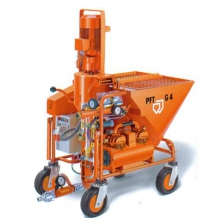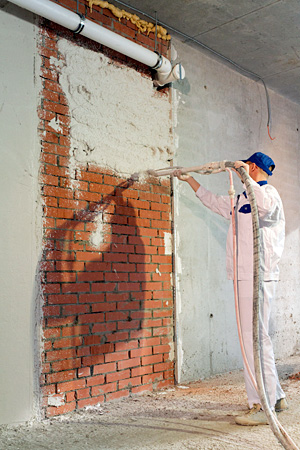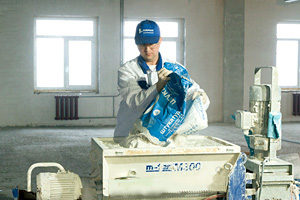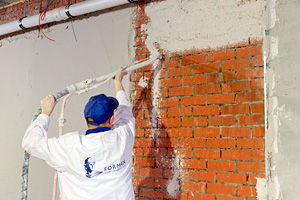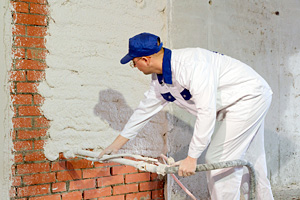How to reduce the repair cost while ensuring sufficiently high quality?
It should be noted that the most costly repair works are leveling of walls and ceilings, as well as floor screeding. Traditionally, plastering has been carried out manually with cement-sand and lime-sand mortars applied to a reinforcing mesh. The main, and perhaps the only advantage of this method is the low cost of the plaster mortar. But there are a lot of drawbacks:
- low speed of work (one plasterer is able to process only 10-12 m2 of walls per day);
- the need for reinforcement;
- significant shrinkage of the mortar during drying, which makes it difficult to level the walls;
- even if walls are plastered for the subsequent wallpapering, further puttying is still required.
Therefore, even with a low cost of plaster mortar, the total cost is significant, the resulting quality sometimes leaves much to be desired, and the timeframes for completing the work are long.
Samara Gypsum Plant proposes to solve these issues with a PFT plastering machine station.
We also offer spare parts and service for these stations.
Scope of application of plastering machine stations
Plastering machine stations have a wide range of applications:
We propose a different approach : instead of plaster mortar, you can use machine-applied gypsum plaster mixes. Such products are slightly more expensive than lime-sand mortars, but this is their only drawback. When you prepare the walls for wallpapering, gypsum plaster mixes eliminate the need of puttying. If the mix is applied using a plastering machine station, the total cost of plastering is often lower than when working with lime-sand mortar.
Plastering machine stations help you complete up to 200 m2 of walls in an eight-hour working day. We propose to introduce world-famous high-performance PFT plastering machine stations into your operations. Model G4 is considered the most popular plastering machine in Europe. Recently, its more advanced and efficient version – G5 – has entered the Russian market. It is also more convenient for transportation. The performance characteristics of these machines allows you to plaster a three-room apartment in 2-3 days while ensuring high quality. In addition to plastering, both stations can be used to pour self-leveling floors. The Samara Region can also boast of supplying the unique PFT RITMO machine that enables both plastering and puttying. Thanks to its compact size and weight of less than 100 kg, this machine is ideal for minor repairs. The unit fits in the trunk of a car and is a perfect choice for small teams of 3-4 people.
These advantages make it possible to set the lowest prices for the work performed and at the same time develop professionally, receive profit and moral satisfaction from quickly and efficiently performed works.
MACHINE PLASTERING: HIGH QUALITY and HIGH SPEED OF WORK. TECHNOLOGY FEATURES
- High-precision plastering machine stations ensure true European quality. This unit is suitable for mortars prepared from various dry mixes (gypsum, gypsum-lime, sand-cement). Undeniable advantages of a plastering station are as follows:
- The high quality of the prepared mortar is ensured by the continuous supply of the dry mix into a separate container, where the mortar is stirred until homogeneous.
- Precise control of the dry-mix-to-water ratio is stable, which is very difficult to achieve manually. Because the prepared mortar is supplied under pressure, high adhesion (setting) to the treated surface is ensured. Machine-applied plaster has better durability and strength.
- The continuous supply of large volumes of the mortar allows you to plaster large areas.
- Machine plastering saves time and human labor costs.
- Dry mortar mixtures for machine application are much cheaper.
MACHINE PLASTERING SAVES TIME
- You won't have to count the weeks before the start of the repair works. Having received the order, the foreman goes to the site, evaluates the scope of work and draws up an estimate. After partial payment, the team of specialists starts plastering work at your site within two working days. The competent guidance of the foreman and the high productivity of the plastering stations make it possible to reduce the time for machine plastering by 4 times compared to manual plastering.
MACHINE PLASTERING SAVES MONEY
- Machine plastering consumes the same amount of material as manual plastering. The required amount of mortar does not depend on the method of application and is determined by the curvature of the walls.
- However, dry mortar mixes for machine plastering are cheaper, which allows saving money on the material.
- In addition, our company has been cooperating with various suppliers of construction materials for a long time, which allows us to buy dry mixes at wholesale prices. Flexible discount programs and the use of our own freight transport contribute to further reduction in your costs.
CRITERIA FOR SELECTING PLASTER STATIONS
The increase in the volume of housing development (both commercial and municipal) and construction of industrial sites and office spaces highlights the necessity to speed up works and reduce the time frames for facility commissioning. The use of dry mortar mixes in mass construction to obtain guaranteed quality of the finish requires using high-performing equipment for plastering, floor screeding, pumping various mortars, lightweight concrete, fine-grained concrete, sandcrete, etc.
Plaster stations or screw pumps (mortar/concrete pumps)? Which vendor is better? What materials are the best - high-quality packaged factory-made dry mortar mixes for machine application or cheap multi-component mixes composed of sand and cement (M100, M150, M200, M300) ? These basic questions establish certain rules for choosing equipment. Let's consider various situations at construction sites and derive the selection criteria.
When choosing a plastering station (a mortar pump, a concrete pump, a screw/piston pump), the most important aspect is the material that you want to use. There are 4 types of available materials:
- Dry mortar mixes packed in bags at the manufacturer's factory for manual application (mixed manually in containers using various mixers or drills).
- Dry mortar mixes packed in bags at the manufacturer's factory for machine application (mixed and applied to the surface to be treated with the help of plastering stations and mortar pumps). Maximum fraction — up to 4 mm.
- Mixes produced by combining several components – for example, dry sand, dry cement, and, in some cases, lime to increase the plasticity of the plaster mortar. Maximum fraction — up to 6mm.
- Ready-made plaster/brickwork mortar or sandcrete transported in automixers from a mortar unit. Maximum fraction — up to 6 mm.
PLASTERING AND POURING OF SCREEDS WITH MATERIALS FOR MACHINE APPLICATION.
CONTRAINDICATIONS. Plastering stations of this type do not support standard dry plaster mixes, sandcrete М300, М150, М200, any liquid ready-made plaster and brickwork mortars, as well as mixes obtained by combining sand with cement and various plasticizers.
PLASTERING AND POURING OF SCREEDS WITH STANDARD DRY PLASTER MIXES (М150, М200), М300 SANDCRETE, AND LIQUID PLASTER MORTARS WITH A GRAIN FRACTION UP TO 6 MM.
A screw pump is the best option for applying standard packaged dry plaster mixes (M100 and M150), the M200 brickwork mortar, the M300 sandcrete, or ready-made plaster mortars transported in automixers with a maximum grain fraction of up to 6 mm, as well as for pumping and applying the mortar produced from cement sand. The global major manufacturers of screw pumps are Putzmeister and PFT. Recommended models – Putzmeister S5 and PFT ZP 3.
These screw pumps are capable of pumping and applying the above mortars to walls up to 120 meters long and up to 80 meters high. The grain fraction in the mortar should not exceed 6-8 mm. The performance of screw pumps is regulated by a variable drive in the range of 5–140 L per minute and depends on the characteristics of the provided screw-and-barrel. The infeed distance and height depend on the material used and its consistency.
CONTRAINDICATIONS. Screw pumps do not support semi-dry low-plasticity mortars for screeds and mortars with a maximum grain fraction exceeding 6-8 mm.
Plastering station is a breakthrough technology for construction sites
Protect the hands and backs of the plasterers. Use a plastering station (plastering machine) to mix, transport via hoses, and apply the mortar to walls and ceilings. The primary purpose of each and every plastering station (plastering machine) is to decrease the physical effort of the plasterer, increase the amount of work per shift, and speed up the commissioning of facilities. Stop wasting your time and health, purchase a plastering station, and work faster and more efficiently!
REMEMBER! You can buy a PLASTERING STATION, but you can’t buy more HEALTH!

